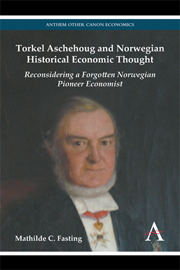 Torkel Aschehoug and Norwegian Historical Economic Thought
Torkel Aschehoug and Norwegian Historical Economic Thought Published online by Cambridge University Press: 05 March 2014
The core group of economists consists of Ebbe Hertzberg (1847–1912), Bredo Morgenstierne (1851–1930) and the younger generation, Oskar Jaeger (1863–1933) and Peder Thorvald Aarum (1867–1926). In addition, Anders Nicolai Kiær (1838–1919) and Nicolai Rygg (1872–1957) respectively a statistician and a jurist, were both appointed chairman of Statistisk centralbureau (later Statistisk sentralbyrå or SSB). The latter was, for a short period of time, the successor to Aschehoug as a professor of economics before he became the general manager of Statistisk centralbureau in 1913.
Ebbe Hertzberg, at only 30 years old, was appointed the first professor of economics and statistics in Norway in 1877 after winning a competition. He was a lawyer, an economist and a historian. He was, as commented on in Chapter 3, a strong adherent of Schweigaard, giving him his full approval in his book published in 1883 about Schweigaard and his public affairs. Due to personal reasons, Hertzberg was forced to resign from his post as professor of economics after just a few years in 1886, and he did not take part in the economic debate until the mid-1890s. Aarum later states that Hertzberg had studied with Karl Knies (1821–1898) in Heidelberg and that he was influenced by the historical school. Like Aschehoug, he lectured and published in Statsøkonomisk Tidsskrift.’
Hertzberg chose ‘Statssocialismens theori’ (The theory of state socialism) as his topic for the first lecture at the Statsøkonomisk forening in 1884.
To save this book to your Kindle, first ensure [email protected] is added to your Approved Personal Document E-mail List under your Personal Document Settings on the Manage Your Content and Devices page of your Amazon account. Then enter the ‘name’ part of your Kindle email address below. Find out more about saving to your Kindle.
Note you can select to save to either the @free.kindle.com or @kindle.com variations. ‘@free.kindle.com’ emails are free but can only be saved to your device when it is connected to wi-fi. ‘@kindle.com’ emails can be delivered even when you are not connected to wi-fi, but note that service fees apply.
Find out more about the Kindle Personal Document Service.
To save content items to your account, please confirm that you agree to abide by our usage policies. If this is the first time you use this feature, you will be asked to authorise Cambridge Core to connect with your account. Find out more about saving content to Dropbox.
To save content items to your account, please confirm that you agree to abide by our usage policies. If this is the first time you use this feature, you will be asked to authorise Cambridge Core to connect with your account. Find out more about saving content to Google Drive.